Extraction and Mass Spectrometric Characterization of Terpenes Recovered from Olive Leaves Using a New Adsorbent-Assisted Supercritical CO2 Process
Abstract
1. Introduction
2. Materials and Methods
2.1. Vegetable Material
2.2. Adsorbent Material
2.3. Supercritical Fluid Extraction
2.4. Adsorption Process
2.5. GC-QTOF-MS Analysis
2.6. Statistical Analysis
3. Results and Discussion
3.1. ScCO2 Extraction of Total Terpenes
3.2. Time-Dependent scCO2 Fractionation of Terpenes from Olive Leaves
3.3. Adsorbent-Assisted scCO2 Fractionation of Olive Leaves
- (1)
- Extraction process: in a first step, solutes dissolve in scCO2 according to its solubility and following the kinetics extraction process shown in Figure 2;
- (2)
- Adsorption process: at the same time, the dissolved compounds interact with the adsorbent through a partition process [38] that depends on the solubility of the compound(s) in scCO2, the chemical surface of the adsorbent, pore size, apparent density, and surface area, among other parameters. Therefore, if affinity of the solutes for the adsorbent is higher than the affinity for scCO2 (solubility), compounds will be retained in the column;
- (3)
- Desorption process: scCO2 removes solutes from the adsorbent; when the amount of CO2 increases, there is a displacement of the equilibrium toward CO2, and adsorbed solutes leave the column and are recovered in the different fractions along the 120 min. Later on, after the processing time, adsorption column is left for 20 min for complete depressurization and the adsorbent is maintained for 2 h in contact with ethanol (with stirring at room temperature) to obtain the last terpene fraction named adsorbate.
3.4. Selective Enrichment of Terpenes in Adsorbent-Assisted scCO2 Extracts
3.5. GC-QTOF-MS Analysis of Terpenoid Compounds in Olive Leaves Extracts
3.6. Differential Terpenoids Composition in Olive Leaves Extracts
4. Conclusions
Author Contributions
Funding
Acknowledgments
Conflicts of Interest
References
- Romero-García, J.M.; Niño, L.; Martínez-Patiño, C.; Álvarez, C.; Castro, E.; Negro, M.J. Biorefinery based on olive biomass. State of the art and future trends. Bioresour. Technol. 2014, 159, 421–432. [Google Scholar] [CrossRef]
- FEDNA Hoja de Olivo (Actualizado November 2015)|FEDNA. Available online: http://www.fundacionfedna.org/node/468 (accessed on 27 November 2020).
- Aghajani, Z.; Engashte-Vahed, A.A.; Khabarizadeh, M. Comparison of the components of the volatile oils of the leaves of two varieties of olea Europaea L. by changing the type of the separation method. Carpathian J. Food Sci. Technol. 2017, 9, 57–63. [Google Scholar]
- Şahin, S.; Şamli, R. Optimization of olive leaf extract obtained by ultrasound-assisted extraction with response surface methodology. Ultrason. Sonochem. 2013, 20, 595–602. [Google Scholar] [CrossRef]
- Ahmad-Qasem, M.H.; Cánovas, J.; Barrajón-Catalán, E.; Micol, V.; Cárcel, J.A.; García-Pérez, J.V. Kinetic and compositional study of phenolic extraction from olive leaves (var. Serrana) by using power ultrasound. Innov. Food Sci. Emerg. Technol. 2013, 17, 120–129. [Google Scholar] [CrossRef]
- Bondioli, P.; Rivolta, G.; Della Bella, L.; Venturini, S.; Rovellini, P. Recovery of triterpene acids from olive leaves. Riv. Ital. delle Sostanze Grasse 2017, 94, 3–8. [Google Scholar]
- Guinda, Á.; Rada, M.; Delgado, T.; Gutiérrez-Adánez, P.; Castellano, J.M. Pentacyclic triterpenoids from olive fruit and leaf. J. Agric. Food Chem. 2010, 58, 9685–9691. [Google Scholar] [CrossRef]
- Guinda, Á.; Castellano, J.M.; Santos-Lozano, J.M.; Delgado-Hervás, T.; Gutiérrez-Adánez, P.; Rada, M. Determination of major bioactive compounds from olive leaf. LWT Food Sci. Technol. 2015, 64, 431–438. [Google Scholar] [CrossRef]
- Roselló-Soto, E.; Koubaa, M.; Moubarik, A.; Lopes, R.P.; Saraiva, J.A.; Boussetta, N.; Grimi, N.; Barba, F.J. Emerging opportunities for the effective valorization of wastes and by-products generated during olive oil production process: Non-conventional methods for the recovery of high-added value compounds. Trends Food Sci. Technol. 2015, 45, 296–310. [Google Scholar] [CrossRef]
- Bisignano, G.; Tomaino, A.; Cascio, R.L.; Crisafi, G.; Uccella, N.; Saija, A. On the In-vitro Antimicrobial Activity of Oleuropein and Hydroxytyrosol. J. Pharm. Pharmacol. 1999, 51, 971–974. [Google Scholar] [CrossRef]
- Moudache, M.; Colon, M.; Nerín, C.; Zaidi, F. Phenolic content and antioxidant activity of olive by-products and antioxidant film containing olive leaf extract. Food Chem. 2016, 212, 521–527. [Google Scholar] [CrossRef] [PubMed]
- Lucetti, D.L.; Lucetti, E.C.; Bandeira, M.A.M.; Veras, H.N.; Silva, A.H.; Leal, L.K.A.; Lopes, A.A.; Alves, V.C.; Silva, G.S.; Brito, G.A.; et al. Anti-inflammatory effects and possible mechanism of action of lupeol acetate isolated from Himatanthus drasticus (Mart.) Plumel. J. Inflamm. 2010, 7, 60. [Google Scholar] [CrossRef] [PubMed]
- Gómez Estrada, H.A.; González Ruiz, K.N.; Medina, J.D. Actividad antiinflamatoria de productos naturales. Bol. Latinoam. y del Caribe Plantas Med. y Aromat. 2011, 10, 182–217. [Google Scholar]
- Difonzo, G.; Russo, A.; Trani, A.; Paradiso, V.M.; Ranieri, M.; Pasqualone, A.; Summo, C.; Tamma, G.; Silletti, R.; Caponio, F. Green extracts from Coratina olive cultivar leaves: Antioxidant characterization and biological activity. J. Funct. Foods 2017, 31, 63–70. [Google Scholar] [CrossRef]
- Goldsmith, C.D.; Vuong, Q.V.; Sadeqzadeh, E.; Stathopoulos, C.E.; Roach, P.D.; Scarlett, C.J. Phytochemical properties and anti-proliferative activity of Olea europaea L. leaf extracts against pancreatic cancer cells. Molecules 2015, 20, 12992–13004. [Google Scholar] [CrossRef]
- Fares, R.; Bazzi, S.; Baydoun, S.E.; Abdel-Massih, R.M. The Antioxidant and Anti-proliferative Activity of the Lebanese Olea europaea Extract. Plant Foods Hum. Nutr. 2011, 66, 58–63. [Google Scholar] [CrossRef]
- Salehi, B.; Mishra, A.P.; Shukla, I.; Sharifi-Rad, M.; Contreras, M.D.M.; Segura-Carretero, A.; Fathi, H.; Nasrabadi, N.N.; Kobarfard, F.; Sharifi-Rad, J. Thymol, thyme, and other plant sources: Health and potential uses. Phyther. Res. 2018, 32, 1688–1706. [Google Scholar] [CrossRef]
- Yu, Y.M.; Chao, T.Y.; Chang, W.C.; Chang, M.J.; Lee, M.F. Thymol reduces oxidative stress, aortic intimal thickening, and inflammation-related gene expression in hyperlipidemic rabbits. J. Food Drug Anal. 2016, 24, 556–563. [Google Scholar] [CrossRef] [PubMed]
- Qiu, J.; Wang, D.; Xiang, H.; Feng, H.; Jiang, Y.; Xia, L.; Dong, J.; Lu, J.; Yu, L.; Deng, X. Subinhibitory Concentrations of Thymol Reduce Enterotoxins A and B and α-Hemolysin Production in Staphylococcus aureus Isolates. PLoS ONE 2010, 5, e9736. [Google Scholar] [CrossRef] [PubMed]
- Evans, J.D.; Martin, S.A. Effects of thymol on ruminal microorganisms. Curr. Microbiol. 2000, 41, 336–340. [Google Scholar] [CrossRef]
- Koc, K.; Cerig, S.; Ucar, S.; Colak, S.; Bakir, M.; Erol, H.S.; Yildirim, S.; Hosseinigouzdagani, M.; Simsek Ozek, N.; Aysin, F.; et al. Gastroprotective effects of oleuropein and thymol on indomethacin-induced gastric ulcer in Sprague-Dawley rats. Drug Chem. Toxicol. 2020, 43, 441–453. [Google Scholar] [CrossRef] [PubMed]
- Machado, K.d.C.; Islam, M.T.; Ali, E.S.; Rouf, R.; Uddin, S.J.; Dev, S.; Shilpi, J.A.; Shill, M.C.; Reza, H.M.; Das, A.K.; et al. A systematic review on the neuroprotective perspectives of beta-caryophyllene. Phyther. Res. 2018, 32, 2376–2388. [Google Scholar] [CrossRef] [PubMed]
- Guinda, Á.; Lanzón, A.; Rios, J.J.; Albi, T. The isolation and quantification of the components from olive leaf: Hexane extract [Aislamiento y cuantificación de los componentes de la hoja del olivo: Extracto de hexano]. Grasas y Aceites 2002, 53, 419–422. [Google Scholar] [CrossRef]
- Jimenez, P.; Masson, L.; Barriga, A.; Chávez, J.; Robert, P. Oxidative stability of oils containing olive leaf extracts obtained by pressure, supercritical and solvent-extraction. Eur. J. Lipid Sci. Technol. 2011, 113, 497–505. [Google Scholar] [CrossRef]
- Issaoui, A.; Ksibi, H.; Ksibi, M. Comparison between several techniques of olive tree bark extraction (Tunisian Chemlali variety). Nat. Prod. Res. 2017, 31, 113–116. [Google Scholar] [CrossRef] [PubMed]
- De Lucas, A.; Martinez De La Ossa, E.; Rincó N A, J.; Blanco, M.A.; Gracia, I. Supercritical fluid extraction of tocopherol concentrates from olive tree leaves. J. Supercrit. Fluids 2002, 22, 221–228. [Google Scholar] [CrossRef]
- Hernndez, L.; Palazon, J.; Navarro-Oca, A. The Pentacyclic Triterpenes amyrins: A Review of Sources and Biological Activities. In Phytochemicals—A Global Perspective of Their Role in Nutrition and Health; InTech: London, UK, 2012. [Google Scholar]
- James, J.T.; Dubery, I.A. Pentacyclic triterpenoids from the medicinal herb, Centella asiatica (L.) Urban. Molecules 2009, 14, 3922–3941. [Google Scholar] [CrossRef]
- Jemmali, Z.; Chartier, A.; Elfakir, C. Development of a gas chromatography-mass spectrometry method to monitor in a single run, mono- to triterpenoid compounds distribution in resinous plant materials. J. Chromatogr. A 2016, 1443, 241–253. [Google Scholar] [CrossRef] [PubMed]
- Sánchez Ávila, N.; Priego Capote, F.; Luque de Castro, M.D. Ultrasound-assisted extraction and silylation prior to gas chromatography-mass spectrometry for the characterization of the triterpenic fraction in olive leaves. J. Chromatogr. A 2007, 1165, 158–165. [Google Scholar] [CrossRef]
- Cosovanu, D.; Llovera, M.; Villorbina, G.; Canela-Garayoa, R.; Eras, J. A simple and fast method for metabolomic analysis by gas liquid chromatography—mass spectrometry. Metabolomics 2021, 17, 22. [Google Scholar] [CrossRef]
- Da Silva, R.P.; Rocha-Santos, T.A.; Duarte, A.C. Supercritical fluid extraction of bioactive compounds. TrAC Trends Anal. Chem. 2016, 76, 40–51. [Google Scholar] [CrossRef]
- Subra, P.; Vega-Bancel, A.; Reverchon, E. Breakthrough curves and adsorption isotherms of terpene mixtures in supercritical carbon dioxide. J. Supercrit. Fluids 1998, 12, 43–57. [Google Scholar] [CrossRef]
- Taamalli, A.; Sánchez, J.L.; Jebabli, H.; Trabelsi, N.; Abaza, L.; Carretero, A.S.; Cho, J.Y.; Román, D.A. Monitoring the bioactive compounds status in olea europaea according to collecting period and drying conditions. Energies 2019, 12, 947. [Google Scholar] [CrossRef]
- Issaoui, A.; Ksibi, H.; Ksibi, M. Supercritical fluid extraction of triterpenes and aliphatic hydrocarbons from olive tree derivatives. Arab. J. Chem. 2017, 10, S3967–S3973. [Google Scholar] [CrossRef]
- Lei, G.; Mao, P.; He, M.; Wang, L.; Liu, X.; Zhang, A. Combination of column adsorption and supercritical fluid extraction for recovery of dissolved essential oil from distillation waste water of Yulania liliiflora. J. Chem. Technol. Biotechnol. 2016, 91, 1896–1904. [Google Scholar] [CrossRef]
- Eggers, R.; Ambrogi, A.; Cardarelli, D.A.; Eggers, R. Separation of Natural Colorants Using a Combined High Pressure Extraction-Adsorption Process. Latin Am. Appl. Res. 2003, 33, 323–326. [Google Scholar]
- Hatami, T.; dos Santos, L.C.; Zabot, G.L.; de Almeida Pontes, P.V.; Caldas Batista, E.A.; Innocentini Mei, L.H.; Martínez, J. Integrated supercritical extraction and supercritical adsorption processes from passion fruit by-product: Experimental and economic analyses. J. Supercrit. Fluids 2020, 162, 104856. [Google Scholar] [CrossRef]
- Győri, E.; Varga, A.; Fábián, I.; Lázár, I. Supercritical CO2 extraction and selective adsorption of aroma materials of selected spice plants in functionalized silica aerogels. J. Supercrit. Fluids 2019, 148, 16–23. [Google Scholar] [CrossRef]
- Flamini, G.; Cioni, P.L.; Morelli, I. Volatiles from leaves, fruits, and virgin oil from Olea europaea cv. Olivastra Seggianese from Italy. J. Agric. Food Chem. 2003, 51, 1382–1386. [Google Scholar] [CrossRef]
- Akram, M.; Nawaz, A. Effects of medicinal plants on alzheimer’s disease and memory deficits. Neural Regen. Res. 2017, 12, 660–670. [Google Scholar] [CrossRef]
- Ali, S.; Nisar, M.; Qaisar, M.; Khan, A.; Khan, A.A. Evaluation of the cytotoxic potential of a new pentacyclic triterpene from rhododendron arboreum stem bark. Pharm. Biol. 2017, 55, 1927–1930. [Google Scholar] [CrossRef] [PubMed]
- Kiyama, R. Estrogenic terpenes and terpenoids: Pathways, functions and applications. Eur. J. Pharmacol. 2017, 815, 405–415. [Google Scholar] [CrossRef]
- Krohn, K. Natural Product Communications: Preface. Nat. Prod. Commun. 2009, 4, 1–4. [Google Scholar]
- Magina, M.D.A.; Dalmarco, E.M.; Dalmarco, J.B.; Colla, G.; Pizzolatti, M.G.; Brighente, I.M.C. Bioactive triterpenes and phenolics of leaves of eugenia brasiliensis. Quim. Nova 2012, 35, 1184–1188. [Google Scholar] [CrossRef]
- Olatunya, A.M.; Akintayo, E.T. Evaluation of the effect of drying on the chemical composition and antioxidant activity of the essential oil of peels from three species of citrus group. Int. Food Res. J. 2017, 24, 1991–1997. [Google Scholar]
- Wojtunik-Kulesza, K.A.; Targowska-Duda, K.; Klimek, K.; Ginalska, G.; Jóźwiak, K.; Waksmundzka-Hajnos, M.; Cieśla, Ł. Volatile terpenoids as potential drug leads in Alzheimer’ s disease. Open Chem. 2017, 15, 332–343. [Google Scholar] [CrossRef]
- Yin, M.C. Inhibitory effects and actions of pentacyclic triterpenes upon glycation. Biomedicine 2015, 5, 1–8. [Google Scholar] [CrossRef]
- Shin, M.; Liu, Q.F.; Choi, B.; Shin, C.; Lee, B.; Yuan, C.; Song, Y.J.; Yun, H.S.; Lee, I.-S.; Koo, B.-S.; et al. Neuroprotective effects of limonene (+) against Aβ42-induced neurotoxicity in a Drosophila model of Alzheimer’s disease. Biol. Pharm. Bull. 2020, 43, 409–417. [Google Scholar] [CrossRef]
- dos Santos Cardoso, A.; Santos, E.G.; da Silva Lima, A.; Temeyer, K.B.; de León, A.A.; Junior, L.M.; dos Santos Soares, A.M. Terpenes on Rhipicephalus (Boophilus) microplus: Acaricidal activity and acetylcholinesterase inhibition. Vet. Parasitol. 2020, 280, 109090. [Google Scholar] [CrossRef]
- Dos Santos, T.C.; Gomes, T.M.; Pinto, B.A.S.; Camara, A.L.; De Andrade Paes, A.M. Naturally occurring acetylcholinesterase inhibitors and their potential use for Alzheimer’s disease therapy. Front. Pharmacol. 2018, 9, 1–14. [Google Scholar] [CrossRef]
- Hsu, C.L.; Fang, S.C.; Huang, H.W.; Yen, G.C. Anti-inflammatory effects of triterpenes and steroid compounds isolated from the stem bark of Hiptage benghalensis. J. Funct. Foods 2015, 12, 420–427. [Google Scholar] [CrossRef]
- Shal, B.; Ding, W.; Ali, H.; Kim, Y.S.; Khan, S. Anti-neuroinflammatory potential of natural products in attenuation of Alzheimer’s disease. Front. Pharmacol. 2018, 9. [Google Scholar] [CrossRef]
- Ayaz, M.; Ullah, F.; Sadiq, A.; Kim, M.O.; Ali, T. Editorial: Natural Products-Based Drugs: Potential Therapeutics Against Alzheimer’s Disease and Other Neurological Disorders. Front. Pharmacol. 2019, 10. [Google Scholar] [CrossRef] [PubMed]
- Koirala, P.; Seong, S.H.; Jung, H.A.; Choi, J.S. Comparative molecular docking studies of lupeol and lupenone isolated from Pueraria lobata that inhibits BACE1: Probable remedies for Alzheimer’s disease. Asian Pac. J. Trop. Med. 2017, 10, 1117–1122. [Google Scholar] [CrossRef] [PubMed]
- Ruszkowski, P.; Bobkiewicz-Kozlowska, T. Natural Triterpenoids and their Derivatives with Pharmacological Activity Against Neurodegenerative Disorders. Mini. Rev. Org. Chem. 2014, 11, 307–315. [Google Scholar] [CrossRef]
- Cocero, M.J.; García, J. Mathematical model of supercritical extraction applied to oil seed extraction by CO2+ saturated alcohol—I. Desorption model. J. Supercrit. Fluids 2001, 20, 229–243. [Google Scholar] [CrossRef]
- Negi, A.S.; Cortesi, A.; Kikic, I.; Bertucco, A.; Calabrese, M.; Solinas, D. Desorption of artemisinin extracts of CIM-Arogya by supercritical carbon dioxide. J. Supercrit. Fluids 2018, 133, 42–48. [Google Scholar] [CrossRef]
- Ribas, M.C.; Mantovani, D.; Awadallak, J.A.; Canevesi, R.L.; Tazinafo, N.M.; Cardozo Filho, L.; Palú, F.; Da Silva, E.A. Study of candeia oil extraction using pressurized fluids and purification by adsorption process. J. Supercrit. Fluids 2014, 92, 177–182. [Google Scholar] [CrossRef]
- Danielski, L.; Brunner, G.; Schwänke, C.; Zetzl, C.; Hense, H.; Donoso, J.P.M. Deterpenation of mandarin (Citrus reticulata) peel oils by means of countercurrent multistage extraction and adsorption/desorption with supercritical CO2. J. Supercrit. Fluids 2008, 44, 315–324. [Google Scholar] [CrossRef]
- Serra, S. Recent Advances in the Synthesis of Carotenoid-Derived Flavours and Fragrances. Molecules 2015, 20, 12817–12840. [Google Scholar] [CrossRef]
- Jung, M.; Kyoung, H.J.; Kim, B.; Bong, H.L.; Byoung, W.C.; Oh, K.B.; Shin, J. Meroditerpenoids from the brown alga Sargassum siliquastrum. J. Nat. Prod. 2008, 71, 1714–1719. [Google Scholar] [CrossRef]
- Dias, M.C.; Figueiredo, C.; Pinto, D.C.; Freitas, H.; Santos, C.; Silva, A.M. Heat shock and UV-B episodes modulate olive leaves lipophilic and phenolic metabolite profiles. Ind. Crops Prod. 2019, 133, 269–275. [Google Scholar] [CrossRef]
- Ben Abdeljelil, Z.; Tekaya, M.; Mechri, B.; Flamini, G.; Hammami, M. Changes in volatiles of olive tree Olea europaea according to season and foliar fertilization. Int. J. Agric. Biol 2017, 19, 1633–1639. [Google Scholar] [CrossRef]
- Haloui, E.; Marzouk, Z.; Marzouk, B.; Bouftira, I.; Bouraoui, A.; Fenina, N. Pharmacological activities and chemical composition of the Olea europaea L. leaf essential oils from Tunisia. J. Food Agric. Environ. 2010, 8, 204–208. [Google Scholar]
- Canabarro, N.I.; Mazutti, M.A.; do Carmo Ferreira, M. Drying of olive (Olea europaea L.) leaves on a conveyor belt for supercritical extraction of bioactive compounds: Mathematical modeling of drying/extraction operations and analysis of extracts. Ind. Crops Prod. 2019, 136, 140–151. [Google Scholar] [CrossRef]
- Şahin, S.; Bilgin, M. Olive tree (Olea europaea L.) leaf as a waste by-product of table olive and olive oil industry: A review. J. Sci. Food Agric. 2018, 98, 1271–1279. [Google Scholar] [CrossRef] [PubMed]
- Sonda, A.; Akram, Z.; Boutheina, G.; Flamini, G.; Mohamed, B. Effect of addition of olive leaves before fruits extraction process to some monovarietal tunisian extra-virgin olive oils using chemometric analysis. J. Agric. Food Chem. 2014, 62, 251–263. [Google Scholar] [CrossRef] [PubMed]
- Rahmanian, N.; Jafari, S.M.; Wani, T.A. Bioactive profile, dehydration, extraction and application of the bioactive components of olive leaves. Trends Food Sci. Technol. 2015, 42, 150–172. [Google Scholar] [CrossRef]
- Orozco-Solano, M.; Ruiz-Jiménez, J.; Luque de Castro, M.D. Ultrasound-assisted extraction and derivatization of sterols and fatty alcohols from olive leaves and drupes prior to determination by gas chromatography-tandem mass spectrometry. J. Chromatogr. A 2010, 1217, 1227–1235. [Google Scholar] [CrossRef] [PubMed]
- Martín-García, B.; Verardo, V.; León, L.; De la Rosa, R.; Arráez-Román, D.; Segura-Carretero, A.; Gómez-Caravaca, A.M. GC-QTOF-MS as valuable tool to evaluate the influence of cultivar and sample time on olive leaves triterpenic components. Food Res. Int. 2019, 115, 219–226. [Google Scholar] [CrossRef]
- Marquez-Martin, A.; De La Puerta, R.; Fernandez-Arche, A.; Ruiz-Gutierrez, V.; Yaqoob, P. Modulation of cytokine secretion by pentacyclic triterpenes from olive pomace oil in human mononuclear cells. Cytokine 2006, 36, 211–217. [Google Scholar] [CrossRef]
- Sánchez-Quesada, C.; López-Biedma, A.; Warleta, F.; Campos, M.; Beltrán, G.; Gaforio, J.J. Bioactive properties of the main triterpenes found in olives, virgin olive oil, and leaves of olea europaea. J. Agric. Food Chem. 2013, 61, 12173–12182. [Google Scholar] [CrossRef] [PubMed]
- Somova, L.I.; Shode, F.O.; Ramnanan, P.; Nadar, A. Antihypertensive, antiatherosclerotic and antioxidant activity of triterpenoids isolated from Olea europaea, subspecies africana leaves. J. Ethnopharmacol. 2003, 84, 299–305. [Google Scholar] [CrossRef]

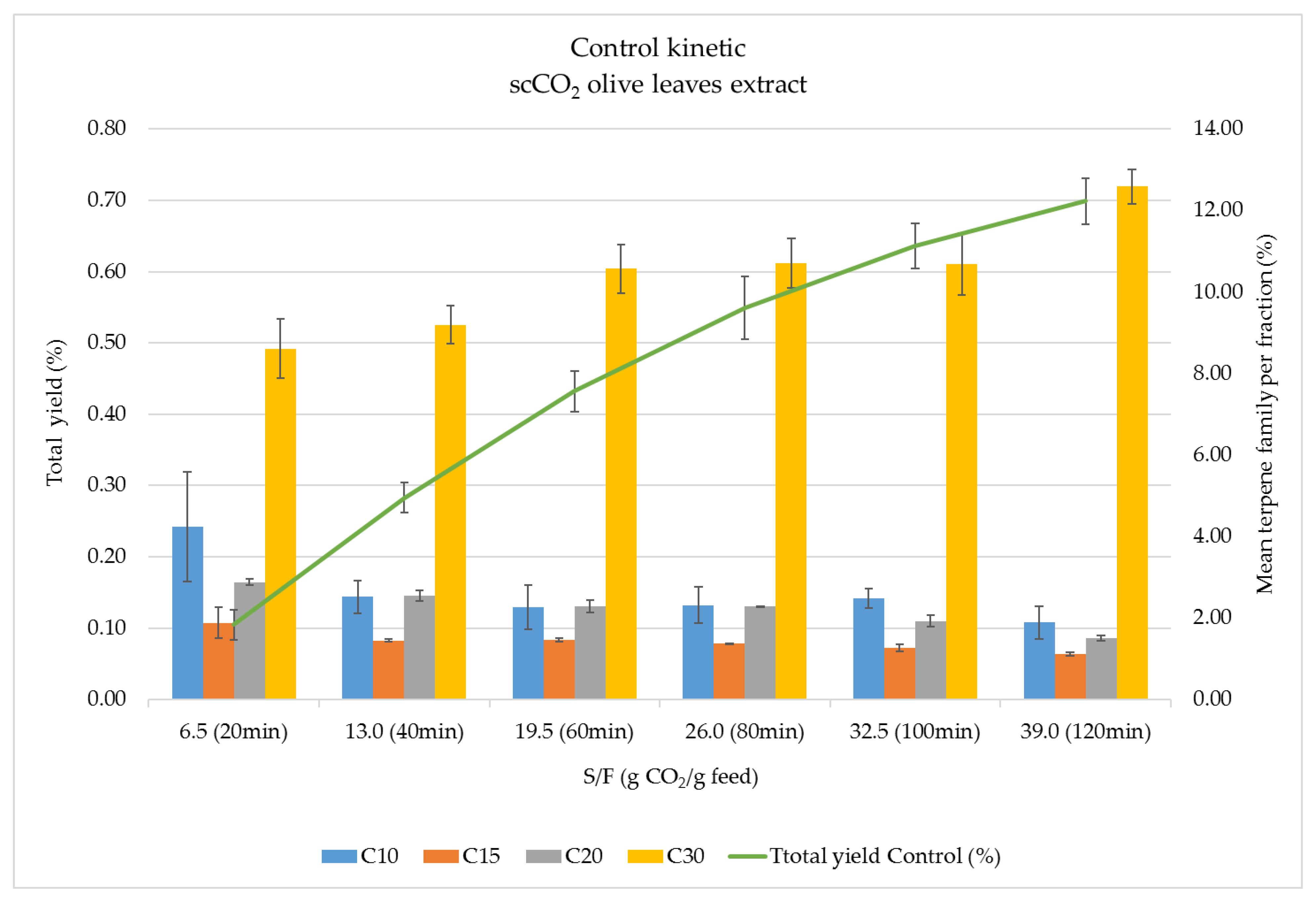
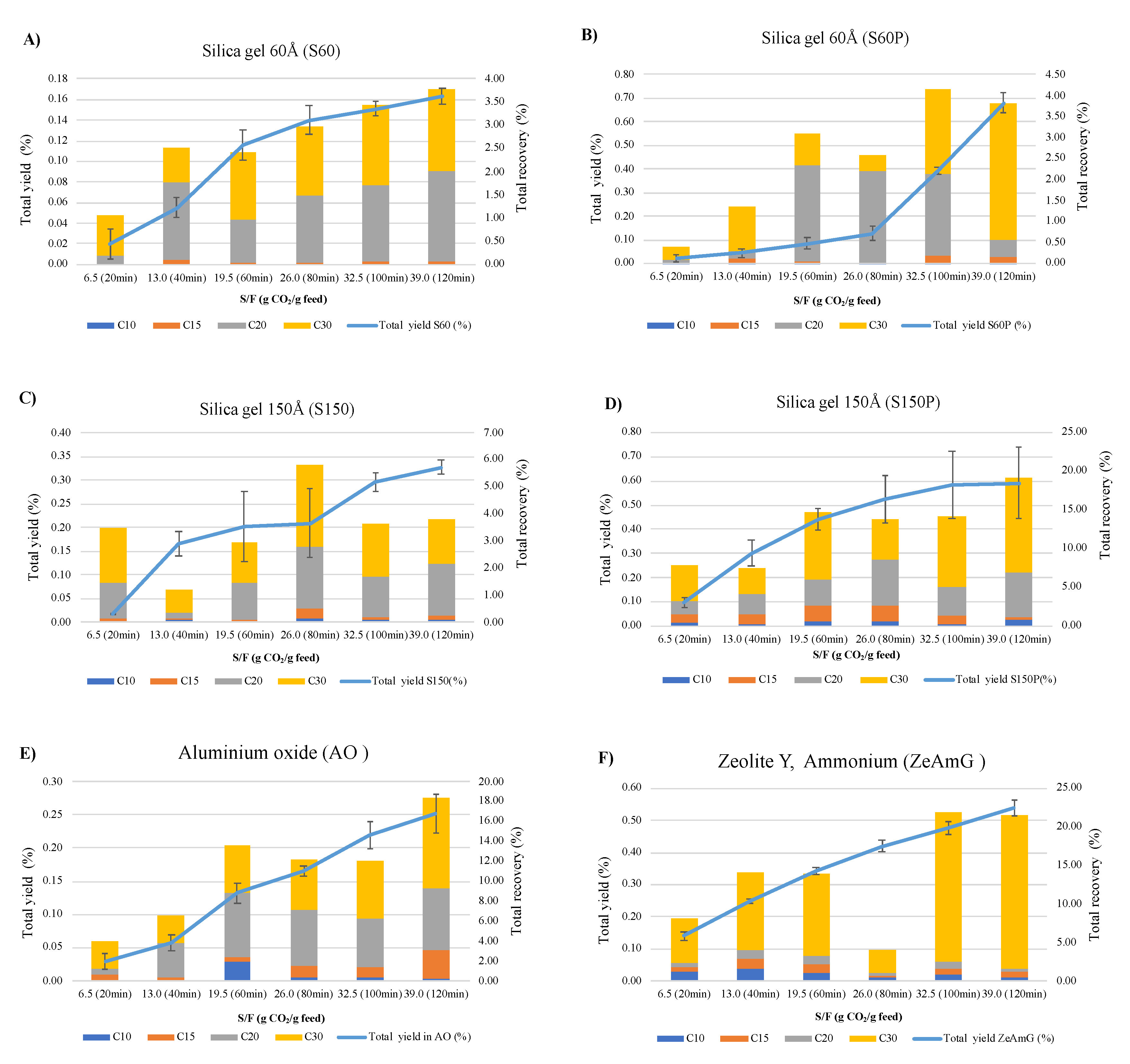
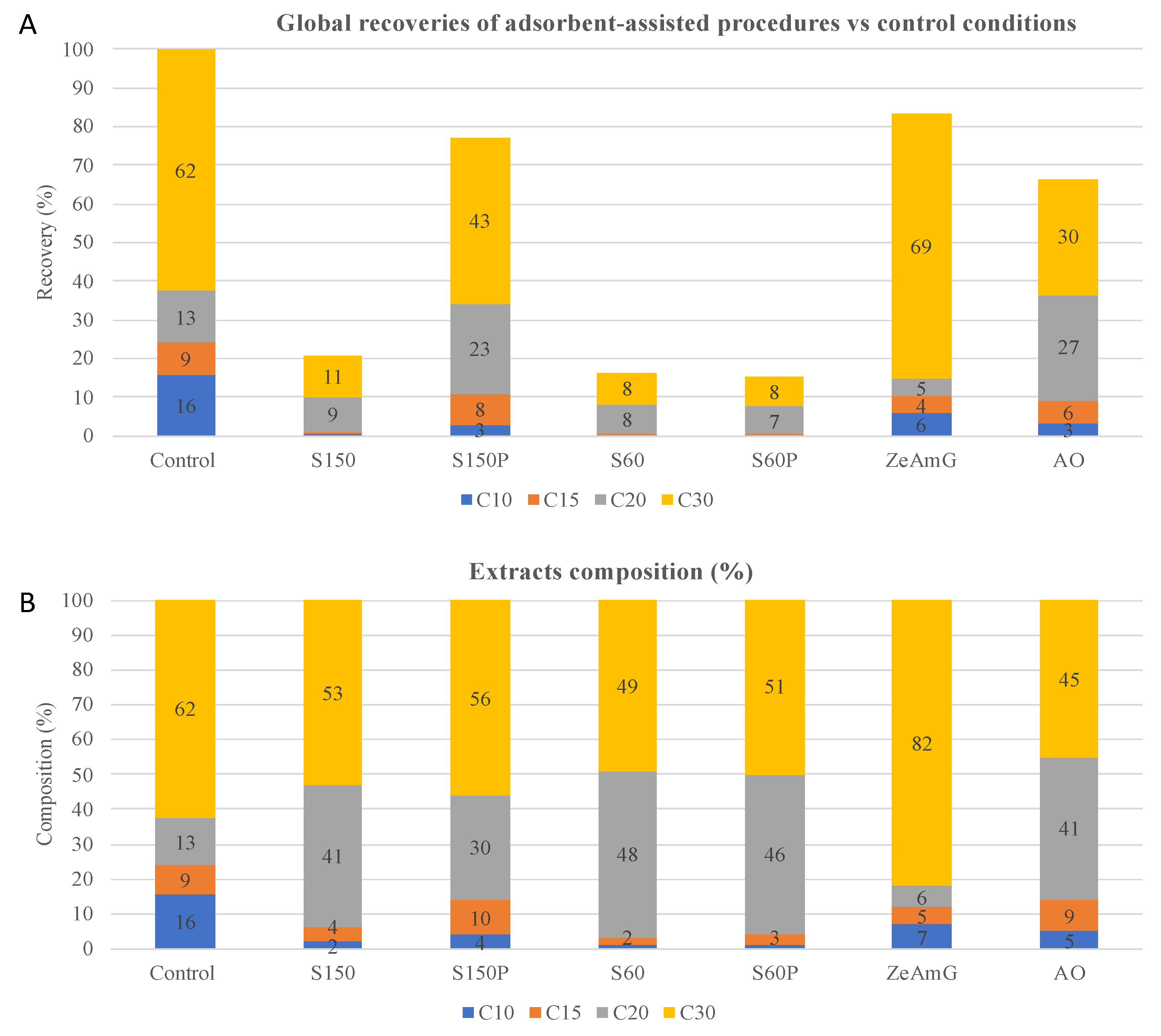
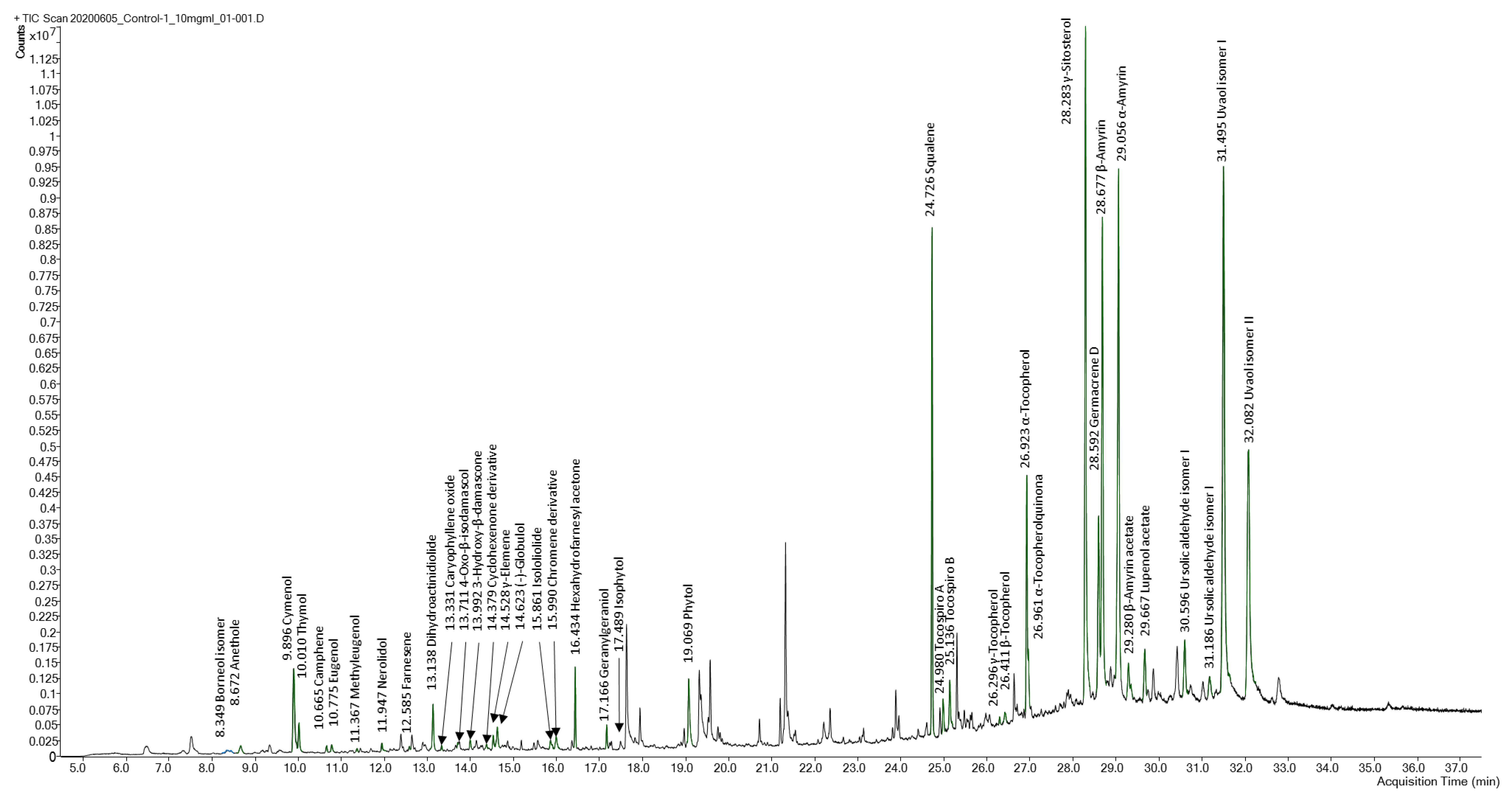
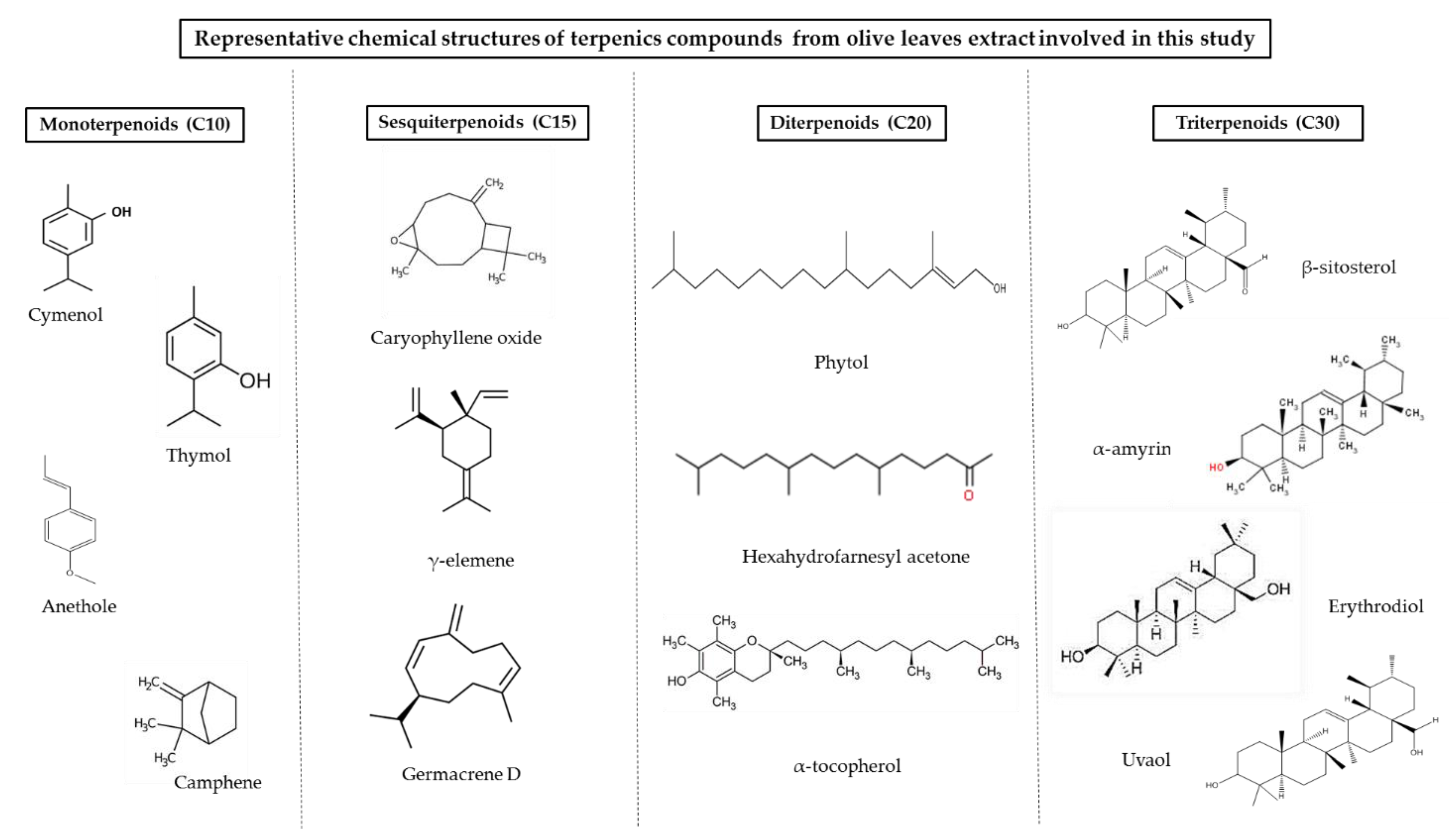
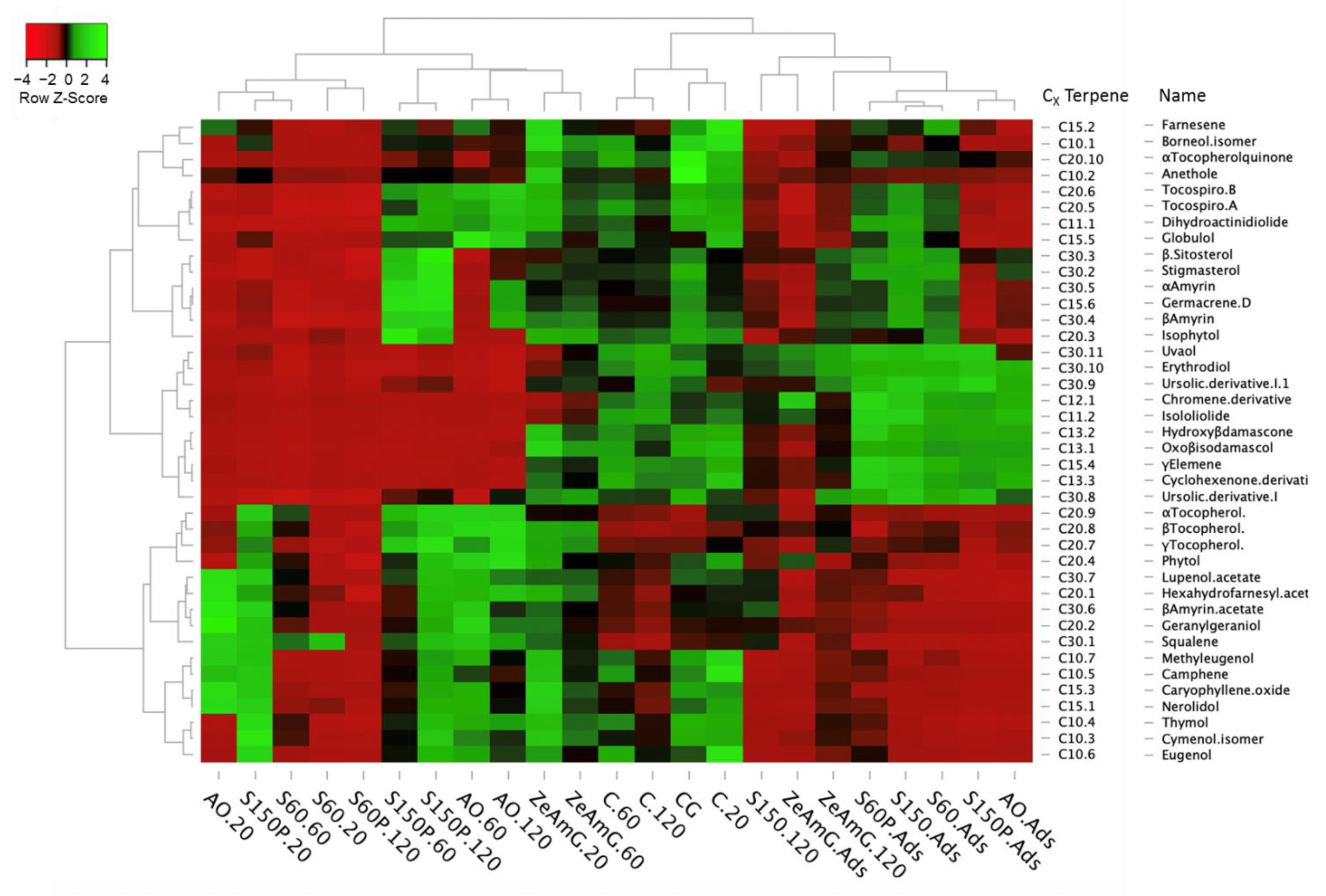
| Name | Pore Size (Å) | Particle Size (mesh) | Surface Area (m2/g) | Bulk Density (mg/cm3) |
|---|---|---|---|---|
| Silica gel (S150) | 150 | 35–60 (250–500 µm) | 300 | 475.4 |
| Silica gel (S150P) | 150 | 200–425 (35–70 µm) | 300 | 413.1 |
| Silica gel (S60) | 60 | 35–60 (250–500 µm) | 480 | 810.6 |
| Silica gel (S60P) | 60 | 230–400 (40–63 µm) | 530 | 613.1 |
| Zeolite Y-ammonium * (ZeAmG) | n.r. | <125 µm | 925 | 623.5 |
| Aluminum oxide 150 Type T (AO) | 58 | 70–230 (60–200 µm) | 205 | 130.4 |
| Family | Compound Name | RT (min) | Formula | MW (g/mol) | Number of Rings | Functional Group | δD | δP | δH | δT | log(Kow) |
|---|---|---|---|---|---|---|---|---|---|---|---|
| Monoterpenoid | Cymenol | 9.89 | C10H14O | 150.22 | 1 | -OH | 18 | 4.9 | 9.1 | 20.8 | 2.5 |
| Monoterpenoid | Thymol | 10.01 | C10H14O | 150.22 | 1 | -OH | 17.8 | 4 | 7.2 | 19.6 | 3.37 |
| Sesquiterpenoid | Germacrene | 28.59 | C15H24 | 204.35 | 2 | 17 | 1.6 | 2.6 | 17.3 | 6.44 | |
| Diterpenoid | Hexahydrofarnesyl acetone | 16.43 | C18H36O | 268.5 | 0 | -CO | 16 | 3.2 | 2 | 16.4 | 7.02 |
| Ditepenoid | α-Tocopherol (Vit E) | 26.92 | C29H50O2 | 430.7 | 1, 1-O | Phenol | 16.9 | 1.5 | 3.6 | 17.3 | 11.06 |
| Ditepenoid | Tocospiro A | 25.13 | C29H50O4 | 462.7 | 1, 1-O | -OH, -CO | 16.5 | 5.1 | 3.8 | 17.7 | 7.39 |
| Triterpenoid | Uvaol | 31.49 | C30H50O2 | 442.7 | 5 | -CH2OH, -OH, | 17.9 | 2.7 | 5.6 | 19 | 9.22 |
| Triterpenoid | β-Amyrin | 28.67 | C30H50O | 426.7 | 5 | -OH | 17.7 | 1.7 | 2.9 | 18.1 | 11.04 |
| Adsorbent | Total Extract Yield (%) | Terpenes Recovery Fractions (%) | C10 (%) | C15 (%) | C20 (%) | C30 (%) | Terpenes Recovery in Adsorbent |
|---|---|---|---|---|---|---|---|
| Control | 0.70 ± 0.03 | - | 15.7 | 8.52 | 13.41 | 62.36 | - |
| S150 | 0.33 ± 0.02 | 20.9 | 0.44 | 0.81 | 8.64 | 11.01 | 12.5 |
| S150P | 0.59 ± 0.14 | 77.1 | 2.83 | 8.06 | 23.17 | 43.05 | 30.9 |
| S60 | 0.16 ± 0.01 | 16.2 | 0.04 | 0.36 | 7.78 | 8.00 | 12.7 |
| S60P | 0.68 ± 0.04 | 15.4 | 0.05 | 0.51 | 7.05 | 7.8 | 13.4 |
| ZeAmG | 0.54 ± 0.02 | 83.5 | 5.88 | 4.34 | 4.69 | 68.59 | 6.1 |
| AO | 0.25 ± 0.03 | 66.6 | 3.25 | 6.04 | 27.24 | 30.07 | 21.9 |
| Peak No | RT (min) | Family | Key | Tentative Identification | Formula | Match Factor | Main Fragments (m/z) b | Reference |
|---|---|---|---|---|---|---|---|---|
| 1 | 8.35 | Monoterpenoid | C10#1 | Borneol isomer | C10H18O | 75 | 121, 110, 95 | |
| 2 | 8.67 | Monoterpenoid | C10#2 | Anethole | C10H12O | 95 | 148, 133, 177, 105 | |
| 3 | 9.90 | Monoterpenoid | C10#3 | Cymenol isomer | C10H14O | 80 | 135, 115, 91 | [40] |
| 4 | 10.01 | Monoterpenoid | C10#4 | Thymol a | C10H14O | 93 | 150, 135, 91 | [63] |
| 5 | 10.67 | Monoterpene | C10#5 | Camphene | C10H16 | 73 | 136, 121, 91 | |
| 6 | 10.78 | Monoterpenoid | C10#6 | Eugenol | C10H12O2 | 96 | 164, 149, 131, 103 | [64] |
| 7 | 11.37 | Monoterpenoid | C10#7 | Methyleugenol | C11H14O2 | 71 | 161, 119, 105 | |
| 8 | 11.95 | Sesquiterpenoid | C15#1 | Nerolidol | C15H26O | 72 | 161, 133, 119, 105, 91 | [64] |
| 9 | 12.59 | Sesquiterpene | C15#2 | Farnesene | C15H24 | 68 | 133, 120, 93, 69 | |
| 10 | 13.14 | Apocarotenoid | C11#1 | Dihydroactinidiolide | C11H16O2 | 80 | 152, 137, 111 | |
| 11 | 13.33 | Sesquiterpenoid | C15#3 | Caryophyllene oxide | C15H24O | 77 | 161, 136, 121, 107, 93 | [3,40,64,65] |
| 12 | 13.71 | Apocarotenoid | C13#1 | 4-Oxo-β-isodamascol | C13H20O2 | 75 | 121, 105, 91, 93, 79 | [3] |
| 13 | 13.99 | Apocarotenoid | C13#2 | 3-Hydroxy-β-damascone | C13H20O2 | 79 | 208, 193, 175 | [3,64] |
| 14 | 14.38 | Apocarotenoid | C13#3 | Cyclohexenone derivative | C13H20O2 | 73 | 161, 136, 121, 105 | |
| 15 | 14.53 | Sesquiterpene | C15#4 | γ-Elemene | C15H24 | 75 | 201, 132, 119, 83 | [65] |
| 16 | 14.62 | Sesquiterpenoid | C15#5 | (-)-Globulol | C15H26O | 81 | 204, 189, 135, 109 | |
| 17 | 15.86 | Apocarotenoid | C11#2 | Isololiolide | C11H16O3 | 76 | 195, 152, 121 | |
| 18 | 15.99 | Meroterpenoid | C12#1 | Chromene derivative | C12H20 | 71 | 212, 197, 155 | |
| 19 | 16.43 | Diterpenoid | C20#1 | Hexahydrofarnesyl acetone | C18H36O | 79 | 124, 109, 95 | [3,66] |
| 20 | 17.17 | Diterpenoid | C20#2 | Geranylgeraniol | C20H34O | 80 | 135, 121, 107, 81 | [3] |
| 21 | 17.49 | Diterpenoid | C20#3 | Isophytol | C20H40O | 85 | 123, 95, 81, 71 | [3] |
| 22 | 19.07 | Diterpenoid | C20#4 | Phytol a | C20H40O | 86 | 123, 95, 81, 71 | |
| [3,23,25,35] 23 | 24.73 | Triterpene | C30#1 | Squalene a | C30H50 | 90 | 410, 341, 136, 121, 109, 81 | [23,25,35] |
| 24 | 24.98 | Meroditerpenoid | C20#5 | Tocospiro A | C29H50O4 | 80 | 419, 402, 137 | |
| 25 | 25.14 | Meroditerpenoid | C20#6 | Tocospiro B | C29H50O4 | 79 | 419, 402, 137 | |
| 26 | 26.30 | Meroditerpenoid | C20#7 | γ-Tocopherol | C28H48O2 | 75 | 416, 191, 151 | [23,26,67] |
| 27 | 26.41 | Meroditerpenoid | C20#8 | β-Tocopherol | C28H48O2 | 76 | 416, 191, 151 | [23,26,67] |
| 28 | 26.92 | Meroditerpenoid | C20#9 | α-Tocopherol a | C29H50O2 | 94 | 430, 205, 165 | [23,26,35,67,68,69] |
| 29 | 26.96 | Meroditerpenoid | C20#10 | α-Tocopherolquinone | C29H50O3 | 72 | 221, 203, 178, 150 | |
| 30 | 27.69 | Triterpenoid | C30#2 | Stigmasterol | C28H48O | 73 | 400, 382, 315, 213 | [70] |
| 31 | 28.28 | Triterpenoid | C30#3 | β-Sitosterol | C29H50O | 86 | 414, 329, 255, 213 | [23,66,70] |
| 32 | 28.59 | Sesquiterpene | C15#6 | Germacrene D | C15H24 | 75 | 204, 189, 175 | |
| 33 | 28.68 | Triterpenoid | C30#4 | β-Amyrin | C30H50O | 88 | 218, 203, 189, 119 | [7,23,67] |
| 34 | 29.06 | Triterpenoid | C30#5 | α-Amyrin a | C30H50O | 81 | 218, 203, 189, 119 | [7,23,67] |
| 35 | 29.28 | Triterpenoid | C30#6 | β-Amyrin acetate | C32H52O2 | 90 | 218, 203, 189, 119 | |
| 36 | 29.67 | Triterpenoid | C30#7 | Lupenol acetate | C30H48O2 | 71 | 189, 161, 135, 121 | |
| 37 | 30.60 | Triterpenoid | C30#8 | Ursolic acid derivative I | C30H48O2 | 70 | 440, 273, 232, 135 | [6,7,8,23,71] |
| 38 | 31.19 | Triterpenoid | C30#9 | Ursolic acid derivative II | C30H48O2 | 75 | 203, 189, 175 | [[6,7,8,23,71] |
| 39 | 31.50 | Triterpenoid | C30#10 | Erythrodiol a | C30H50O2 | 87 | 234, 203, 119 | [7,30,72,73] |
| 40 | 32.08 | Triterpenoid | C30#11 | Uvaol a | C30H50O2 | 88 | 234, 203, 119 | [6,7,8,23,30,66,71,73,74] |
Publisher’s Note: MDPI stays neutral with regard to jurisdictional claims in published maps and institutional affiliations. |
© 2021 by the authors. Licensee MDPI, Basel, Switzerland. This article is an open access article distributed under the terms and conditions of the Creative Commons Attribution (CC BY) license (https://creativecommons.org/licenses/by/4.0/).
Share and Cite
Suárez Montenegro, Z.J.; Álvarez-Rivera, G.; Mendiola, J.A.; Ibáñez, E.; Cifuentes, A. Extraction and Mass Spectrometric Characterization of Terpenes Recovered from Olive Leaves Using a New Adsorbent-Assisted Supercritical CO2 Process. Foods 2021, 10, 1301. https://doi.org/10.3390/foods10061301
Suárez Montenegro ZJ, Álvarez-Rivera G, Mendiola JA, Ibáñez E, Cifuentes A. Extraction and Mass Spectrometric Characterization of Terpenes Recovered from Olive Leaves Using a New Adsorbent-Assisted Supercritical CO2 Process. Foods. 2021; 10(6):1301. https://doi.org/10.3390/foods10061301
Chicago/Turabian StyleSuárez Montenegro, Zully J., Gerardo Álvarez-Rivera, Jose A. Mendiola, Elena Ibáñez, and Alejandro Cifuentes. 2021. "Extraction and Mass Spectrometric Characterization of Terpenes Recovered from Olive Leaves Using a New Adsorbent-Assisted Supercritical CO2 Process" Foods 10, no. 6: 1301. https://doi.org/10.3390/foods10061301
APA StyleSuárez Montenegro, Z. J., Álvarez-Rivera, G., Mendiola, J. A., Ibáñez, E., & Cifuentes, A. (2021). Extraction and Mass Spectrometric Characterization of Terpenes Recovered from Olive Leaves Using a New Adsorbent-Assisted Supercritical CO2 Process. Foods, 10(6), 1301. https://doi.org/10.3390/foods10061301









